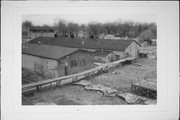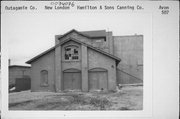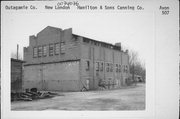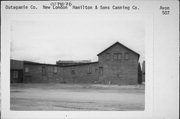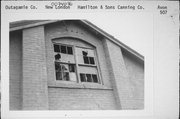| Additional Information: | Photo codes: OUT-FRV 1/2A-13A. See HAER form.
OAHP INVENTORY (08/1980):
The Hamilton and Sons Canning Company of New London was founded in 1919 by Emil Hamilton, a cooper from Milwaukee. Its original officers were Emil Hamilton (president), Abe E. Hamiltion (vice-president), and Henry E. Hamilton (secretary and treasurer). The plant initially was reported to be small, consisting primarily of a two-story frame building with concrete floor and wooden beam construction. Thirty-five thousand cases of kraut were packed the first year. By 1930, 800,000 cases were being packed and the plant was described as the largest canner of kraut in the U.S., a distinction it held for perhaps a decade or more. Plant operations in 1930 consisted of 11 buildings on 7 acres of land. During WWII the company served as a prisoner of war camp, with an estimated 150 Germans. It was also the official purveyor of pickles and pickle products for the White House from 1935-1975. In the 1960's, the main part of the canning operations, that dealing with the kraut, was torn down. In 1974, the firm closed following a 7 week strike that combined with a large increase in sugar prices in that year, is said to have significantly disrupted production and increased costs. The strike was the first ever among canning facilities in Wisconsin, as well as, reportedly, the first ever in New London.
Those buildings which exist today are largely vacant, with teh exception of a machine shop and office, but do contain some remnant pieces of the canning operations, such as crocks, laboratory equipment, machine parts and office furnishings. Buildings existing include: (1) one-story wood frame office; (2) one-story wood frame machine shop; (3) two-story wood frame "summer room" used for cutting and washing incoming products; (4) two-story wood frame building where the products were sorted and canned; (5) two-story wood frame warehouse; (6) three-story wood frame "pickle house" which housed the packing operations; (7) condemned three-story concrete block processing building; (8) one-story brick power generating building. Also existing are parts of an outdoor wooden tramway and a few wooden pickle vats, some 166 vats, 1.4 feet in diameter built of cyprus and redwood, filled with saline solution, were once used to store the pickles.
|
|---|

